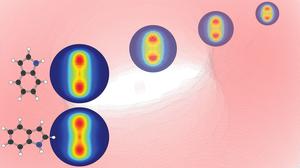Biomolecular building blocks gripped by laser published by Nature Communications
17 March, 2022
DESY team accurately aligns indole molecules and positions them for a detailed examination
Next to the structure of the biomolecule indole in two selected orientations (left), one can see the measured signals indicating that these molecules are ideally aligned. To the right, one sees one of the molecular orientations during the lapse of time, which is determined in the experiment by measuring the momentum of hydrogen ions in the molecule. Image: DESY, J. Küpper/C. Lopez Gonzalez
Laser pulses that briefly grab hold of floating molecules and align them precisely in space – this may sound like an original but academic party trick, however the technique which the team led by DESY’s Jochen Küpper is now presenting in the scientific journal Nature Communications has great potential for research, too, because arranging molecules in a precise spatial configuration is an important precondition for observing their extremely rapid behaviour in detail and even filming it. With their latest study, the experts have now managed for the first time to strongly align a relatively complex structure – the biomolecule indole – without the presence of a laser field. In the future, it should also be possible to use the new method on other complex molecules such as amino acids, neurotransmitters or vitamins, and possibly even entire proteins.
For some time now, it has been possible, in principle, to take hold of complex molecules and align them using short laser pulses. However, to do this the laser usually has to be active all the time, which is undesirable when doing certain kinds of experiments – especially ones aimed at closely observing the chemical behaviour of a molecule. “We have developed a new technique, whereby after aligning the molecule using a pulse with a long rise time, the laser is quickly switched off again,” explains Jochen Küpper, lead scientist at DESY, professor at Universität Hamburg and a member of the Cluster of Excellence AIM at the Centre for Ultrafast Imaging. “This allows the aligned molecule to be studied without any disturbance by the laser field.”
Some time ago, Küpper’s team already managed, using a similar technique, to hold and manipulate a simple rod-shaped molecule, carbonyl sulphide, which consists of one atom each of oxygen, carbon and sulphur. More specifically, the group was able to get the tiny rod to rotate by applying a brief laser kick and then literally film this quantum mechanical rotation using a special detection method. The result was an extremely short film consisting of 651 individual images and recorded in 120 trillionths of a second. This corresponds to recording an entire “quantum carpet” – and even made it into the Guinness Book of Records. On top of this, a special electron diffraction experiment based on this control was able to determine the length of the chemical bonds in carbonyl sulphide to within 5 trillionths of a metre – another world record.
In their latest study, the team has now succeeded in aligning a significantly more complex molecule using a laser pulse. Indole is a biomolecule that, among other things, plays a role in the body’s absorption of ultraviolet radiation, for example in developing sunburn and protecting against it. “One of the challenges was switching off our lasers quickly enough once they had aligned the indole molecules,” explains Küpper. They managed to switch them off extremely abruptly, within a few picoseconds, i.e. a few trillionths of a second. This abrupt stop was achieved by cleverly controlling LCD displays similar to those found in some televisions and computer monitors.
After switching off the laser, there is only a small window of time before the molecule twists out of alignment again; but that time is long enough to excite the indole using ultraviolet radiation and to measure its response using ingenious methods. In order to resolve the individual components of the molecule, it is necessary for the alignment to be as precise as possible – it does after all make a substantial difference to the analyses whether the molecule is “standing up” or “lying down”.
Demonstrating that the indole molecules had in fact been aligned proved to be challenging, however. To achieve this, the experts shone high-intensity infrared light at the molecule, causing it to break apart into many fragments. In the process, numerous hydrogen and carbon atoms were torn off, whose momenta were measured using special detectors. “To deduce the original orientation of the indole from these measurements, we had to develop a sophisticated method of analysis,” explains Küpper.
In future experiments, the scientists intend to determine as precisely as possible the positions of the individual atoms that make up the indole and the role of their respective movements in the reactions. The technique promises to do much more, though: “In principle, it could be used to align and study all kinds of molecules, such as vitamins, neurotransmitters or perhaps even proteins,” Küpper believes. “This means, we have given science a new analytical tool with which to understand the properties of such molecules in more detail in the future.”
Scientists from DESY, the Universität Hamburg and the Max Born Institute in Berlin were involved in the research.
